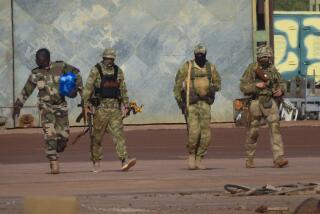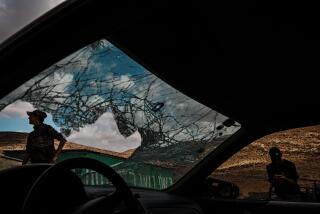Living with death by drone
Last week, Stanford University and New York University released a major study about the use of drones in the ever-evolving but never-ending war on terror. Unfortunately, many commentators missed the report’s key message: Drones are terrorizing an entire civilian population.
I was one of the researchers for the study, and spent weeks in Pakistan interviewing more than 60 people from North Waziristan. Many were survivors of strikes. Others had lost loved ones and family members. All of them live under the constant threat of annihilation.
What my colleagues and I learned from these unnamed and unknown victims of America’s drone warfare gave the report its title: “Living Under Drones.”
People in the United States imagine that drones fly to a target, launch their deadly missiles with surgical precision and return to a U.S. base hundreds or thousands of miles away. But drones are a constant presence in the skies above the North Waziristan tribal area in Pakistan, with as many as six hovering over villages at any one time. People hear them day and night. They are an inescapable presence, the looming specter of death from above.
And that presence is steadily destroying a community twice the size of Rhode Island. Parents are afraid to send their children to school. Women are afraid to meet in markets. Families are afraid to gather at funerals for people wrongly killed in earlier strikes. Drivers are afraid to deliver food from other parts of the country.
The routines of daily life have been ripped to shreds. Indisputably innocent people cower in their homes, afraid to assemble on the streets. “Double taps,” or secondary strikes on the same target, have stopped residents from aiding those who have been injured. A leading humanitarian agency now delays assistance by an astonishing six hours.
What makes this situation even worse is that no one can tell people in these communities what they can do to make themselves safe. No one knows who is on the American kill list, no one knows how they got there and no one knows what they can do to get themselves off. It’s all terrifyingly random. Suddenly, and without warning, a missile launches and obliterates everyone within a 16-yard radius.
Naturally, the Obama administration claims it strikes only militants. But if we have learned anything since 9/11, it is that we must all read the fine print. What people do not appreciate is that the administration defines militants as all military-age males, typically those between 18 and 65. In addition, because the U.S. generally does not release the names of people who have been killed, we cannot know whether the victims were actually militants or were deemed militants simply because Washington says they were.
Indeed, the entire process is riddled with the same sort of flaws that beset the detention regime at the military prison in Guantanamo Bay, Cuba. In Afghanistan, the Bush administration paid enormous bounties in an effort to get information on the ground. In areas rife with tribal and familial rivalries, the result was predictable: Hundreds of innocent people were wrongly fingered as Taliban or Al Qaeda, many of whom spent years at Guantanamo or other American prisons overseas.
Now the United States is offering similar incentives to people in North Waziristan who promise to identify militants. The alleged militants’ homes are tagged by GPS trackers and later, when the informant is at a safe distance, blown to smithereens. And because no one knows who the informants are, people are reluctant to invite neighbors into their homes. The entire community withdraws from the public square, afraid to venture out but equally afraid to bring the outside in.
This is what it means to live under drones. It has turned North Waziristan into the world’s largest prison, a massive occupied zone. A humanitarian worker who was in New York on 9/11 and is now working in North Waziristan told us that the atmosphere in the two places feels very much the same. The constant sense of terror is a feeling that knows no boundaries.
Of course, we should ask whether drones are legal under international law; my view is that they are not. Of course, we should ask whether drones are counterproductive; my view is that they are.
But no discussion of the issue is remotely complete unless we come to grips with what it means to be living under drones.
Jennifer Gibson is a staff attorney with Reprieve, a London-based legal charity that represents dozens of Pakistani drone victims. She was part of the Stanford research team that visited Pakistan and is a coauthor of “Living Under Drones.”
More to Read
A cure for the common opinion
Get thought-provoking perspectives with our weekly newsletter.
You may occasionally receive promotional content from the Los Angeles Times.










